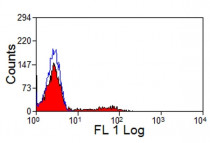ARG22507
anti-CD39 antibody [A1]
anti-CD39 antibody [A1] for CyTOF®-candidate,Flow cytometry,ICC/IF and Human
Overview
| Product Description | Mouse Monoclonal antibody [A1] recognizes CD39 This antibody recognizes the human CD39 cell surface antigen, a ~70-100 kDa molecule expressed on peripheral blood B cells, T cells and monocytes, and weakly expressed by granulocytes.CD39 has intrinsic ecto-ATPase activity (Wang et al. 1996), and expression can be induced on T cells and increased on B cells, as a late activation antigen (Maliszewski et al. 1994).Mouse anti Human CD39, clone A1 has been shown to block MHC independent target cell recognition by hapten-specific CTL (Scholzen et al. 2009). |
|---|---|
| Tested Reactivity | Hu |
| Tested Application | CyTOF®-candidate, FACS, ICC/IF |
| Host | Mouse |
| Clonality | Monoclonal |
| Clone | A1 |
| Isotype | IgG1 |
| Target Name | CD39 |
| Antigen Species | Human |
| Immunogen | PHA activated human lymphocytes |
| Conjugation | Un-conjugated |
| Alternate Names | CD39; Ecto-ATPase 1; Ecto-ATPDase 1; CD antigen CD39; NTPDase-1; ATPDase; EC 3.6.1.5; Ecto-ATP diphosphohydrolase 1; NTPDase 1; Ectonucleoside triphosphate diphosphohydrolase 1; SPG64; Ecto-apyrase; Lymphoid cell activation antigen |
Application Instructions
| Application Suggestion |
|
||||||||
|---|---|---|---|---|---|---|---|---|---|
| Application Note | FACS: Use 10ul of the suggested working dilution to label 10^6 cells * The dilutions indicate recommended starting dilutions and the optimal dilutions or concentrations should be determined by the scientist. |
Properties
| Form | Liquid |
|---|---|
| Purification | Purification with Protein A. |
| Buffer | PBS and 0.09% Sodium azide |
| Preservative | 0.09% Sodium azide |
| Concentration | 1 mg/ml |
| Storage Instruction | For continuous use, store undiluted antibody at 2-8°C for up to a week. For long-term storage, aliquot and store at -20°C or below. Storage in frost free freezers is not recommended. Avoid repeated freeze/thaw cycles. Suggest spin the vial prior to opening. The antibody solution should be gently mixed before use. |
| Note | For laboratory research only, not for drug, diagnostic or other use. |
Bioinformation
| Database Links |
Swiss-port # P49961 Human Ectonucleoside triphosphate diphosphohydrolase 1 |
|---|---|
| Gene Symbol | ENTPD1 |
| Gene Full Name | ectonucleoside triphosphate diphosphohydrolase 1 |
| Background | The protein encoded by this gene is a plasma membrane protein that hydrolyzes extracellular ATP and ADP to AMP. Inhibition of this protein's activity may confer anticancer benefits. Several transcript variants encoding different isoforms have been found for this gene. [provided by RefSeq, Aug 2015] |
| Function | In the nervous system, could hydrolyze ATP and other nucleotides to regulate purinergic neurotransmission. Could also be implicated in the prevention of platelet aggregation by hydrolyzing platelet-activating ADP to AMP. Hydrolyzes ATP and ADP equally well. [UniProt] |
| Highlight | Related products: CD39 antibodies; Anti-Mouse IgG secondary antibodies; Related news: CyTOF-candidate Antibodies |
| Calculated MW | ~ 70 - 100 kDa |
| PTM | The N-terminus is blocked. Palmitoylated in the N-terminal part. |
Images (1) Click the Picture to Zoom In






